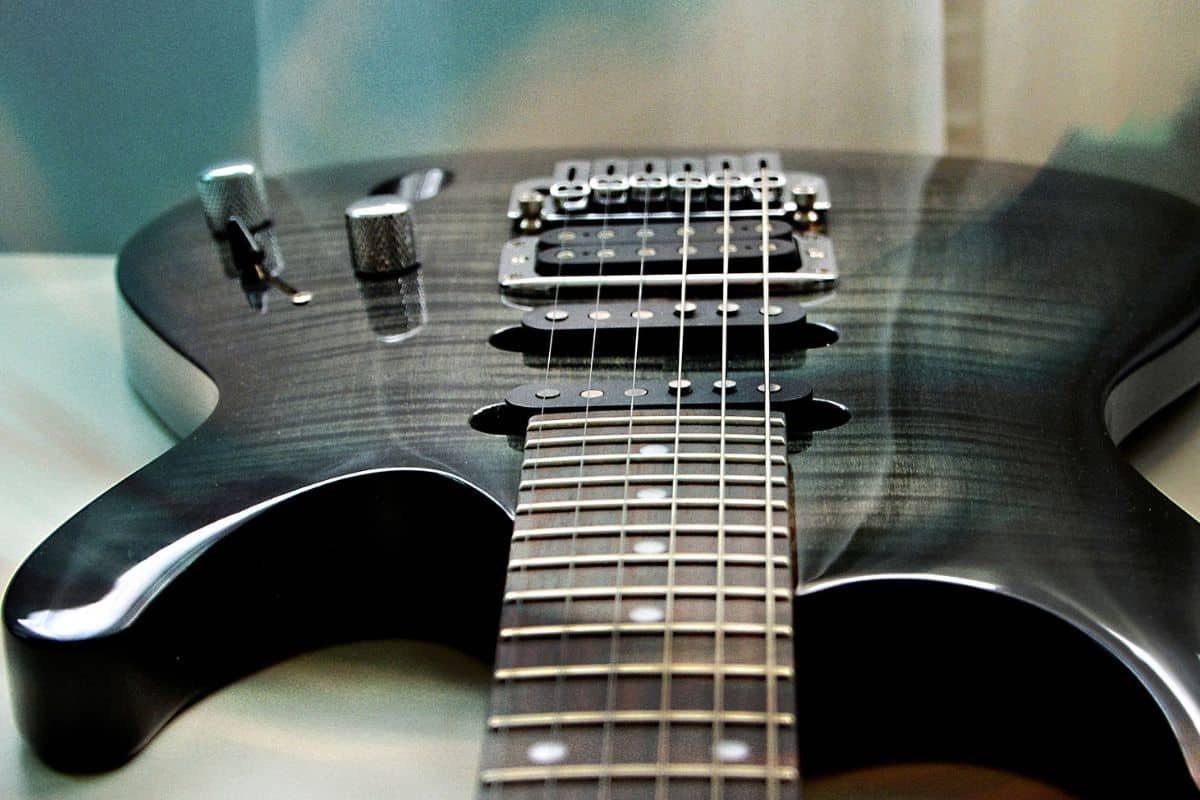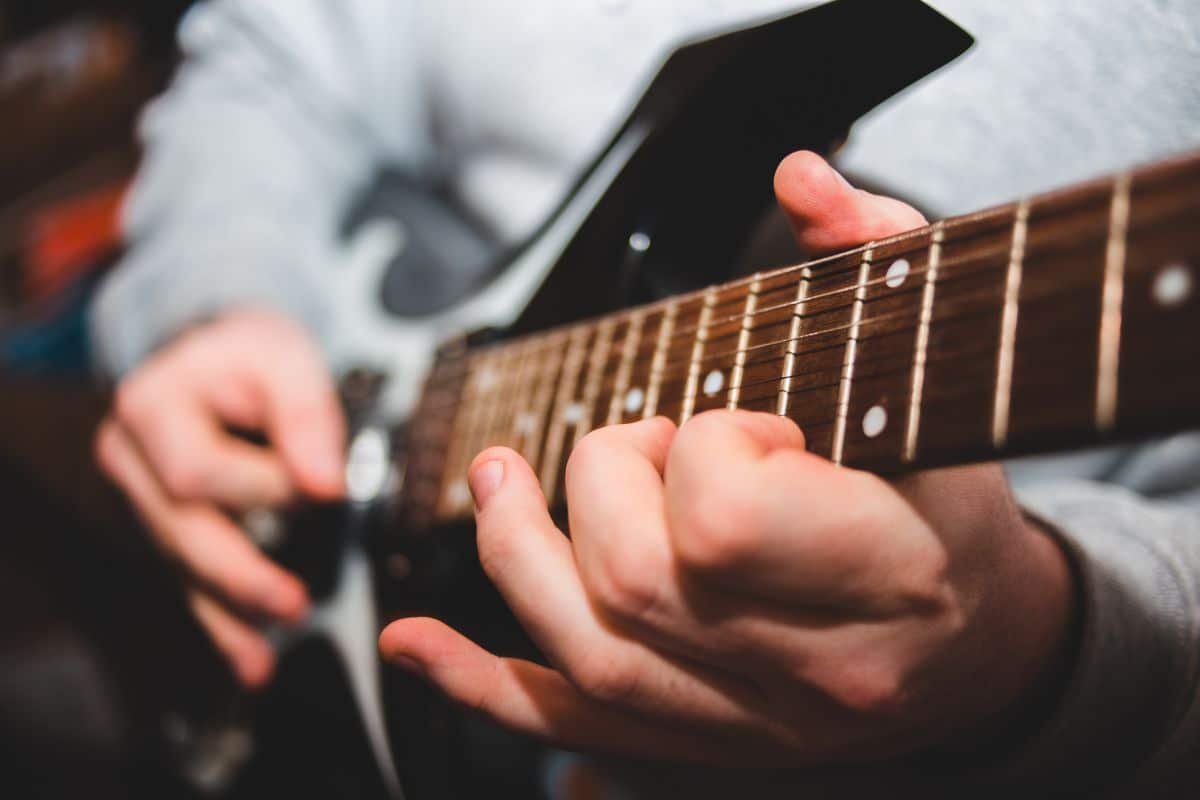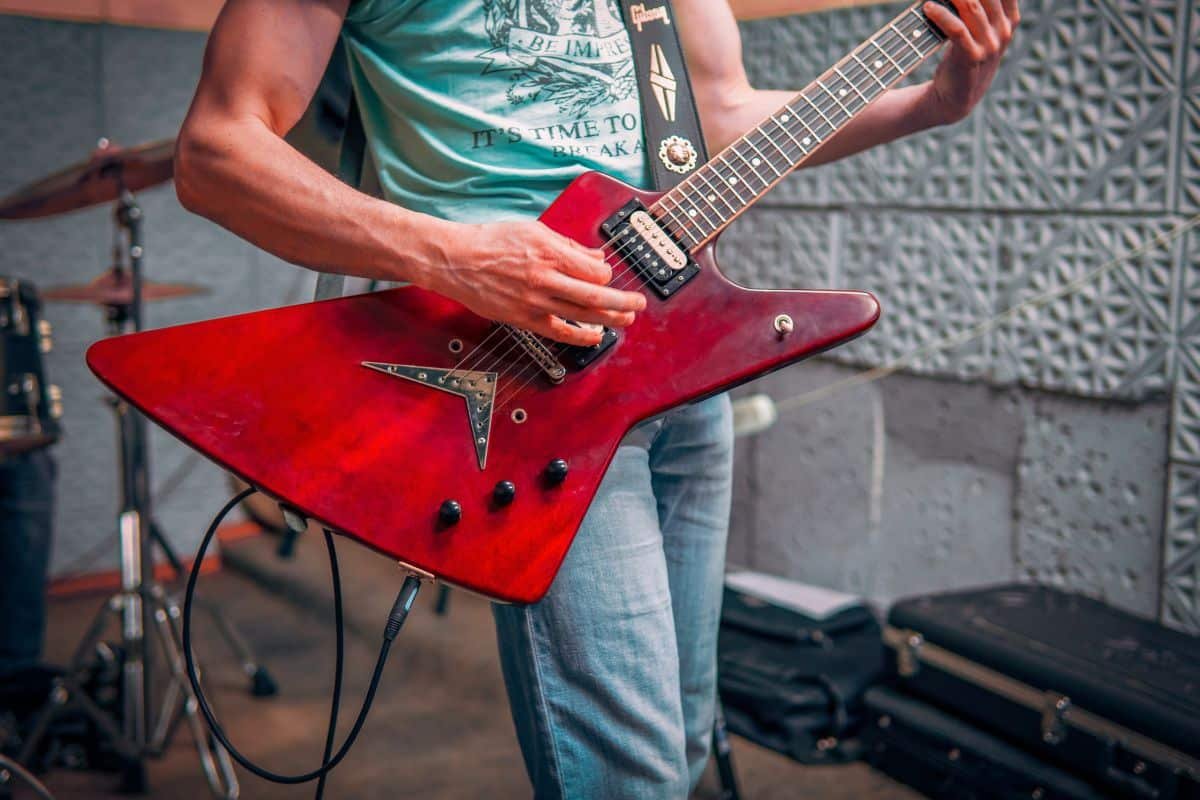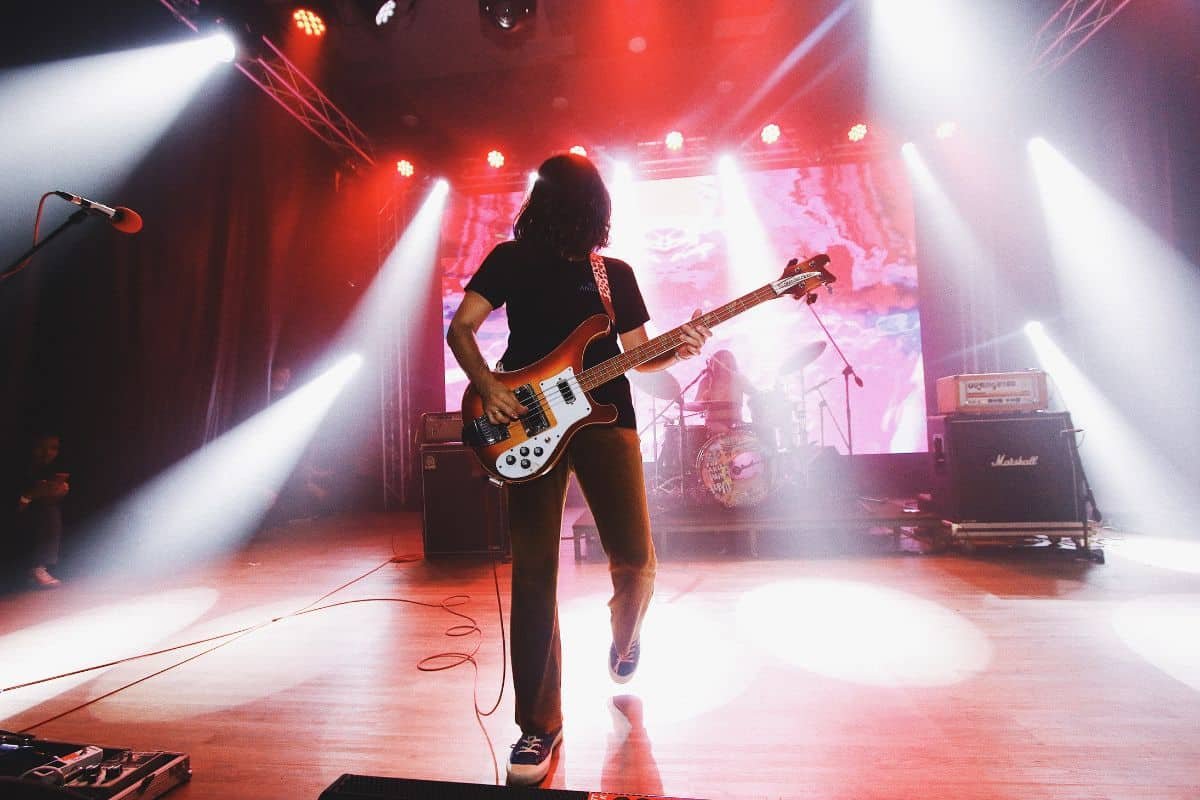If you were to list some of the seminal metal bands, then your list wouldn’t count for much if it didn’t have Pantera in there, and the guitar work of Dimebag Darrell has been crucial in influencing the sound of metal music, making it as heavy as a sledgehammer to the chest.
But how did Dimebag achieve this inimitable sound? Well, one of the ways he did it was through his guitar sound.
Dimebag was known to favor certain guitars and gear, so if you are craving that same rasping thrash metal sound, you’ll want to grab the same gear.
So, what guitars does Dimebag use? How did they influence his guitar sound?
What other pedals and gadgets do you need to recreate the Dimebag Darrell tone?
Well, we’re going to do Dimebag Darrell’s complete rig rundown so you can start shredding like this thrash metal legend.
Contents
Dimebag Darrell – The Guitar Behind The Legend
Dimebag Darrell is known for playing primarily Dean ML guitars right through the 80s and up until the 90’s when Dean stopped making guitars altogether for a few years.
The one guitar that Dimebag is most well-known for is his V-shaped Dean guitar.
But what’s so special about it?
Well, apart from the amazing sound he managed to wring out of it (more of which later), it was because it had such a striking look.
This guitar was sprayed a vivid blue color and came with forked lightning that emerged from the pickup and out towards the edges.
Anybody who went to see Pantera in their prime or even Damageplan, his project after
Pantera, would have been desperate to see his lightning flying V.
However, Dimebag had many guitars in his roster and was known to be a fan of vivid paint jobs.
This was all part of the Dimebag flare that he brought to his performance, his look and his guitar playing.
But what were the main guitars that he used on stage and in the studio?
We’re going to have a rundown of all the guitars that Dimebag used most frequently. Going from some of his signature pieces right the way down to one-off rarities.
Dimebag Darrell Guitar List
1. The Dean From Hell
When Pantera fans think of the band, the Dimebag signature guitar is probably the first thing that comes to mind.
This guitar was awarded to Dimebag as the first prize in a guitar-playing competition, which was originally colored cherry.

The funny story behind the origins of this guitar was that Dimebag came to own 2 very close together.
This was because, in tandem with winning his first Dean ML, his father had ordered another
Dean ML for him that arrived on the very same night that Dimebag received his first one! How’s that for fate?
However, this was short-lived, as Dimebag sold the guitar that he won in the competition so that he could buy his first car.
But it was with this treasured guitar that Dimebag began to cultivate his early sound.
The way this guitar got its signature look is through the famous guitar painter and custom body-builder Buddy Blaze.
The pickups were whipped out and exchanged for a Bill Lawrence XL500 and a Seymour Duncan pickup in the neck.
This would form part of the core tone that Dimebag would maintain throughout his other guitars.
This has 2 traction volume knobs, one master volume knob, and one mahogany body with a rosewood fretboard.
The V-shape on the guitar facilitates much faster fingerwork, which is what accounts for Dimebag’s unbelievable shredding ability.
The original guitar features a Kiss sticker on the bottom of the guitar, along with scorch marks along the bottom, which have been acquired from Dimebag firing bottle rockets from the guitar during numerous Pantera shows.
It also comes with ‘Dean From Hell’ written at the top in black felt pen.
To round the whole guitar off, a Floyd Rose tremolo was put in the bridge to bend those notes in the only way that Dimebag Darrell could.
Later, Dimebag would ask Buddy to make a special guitar for him that he nicknamed ‘the Dime’.
However, in an amazing twist of fate, Buddy had other plans up his sleeve.
The guitar that he was charged with making he delivered to Dimebag, although it was the initial guitar that Dimebag had won in the guitar competition all those years ago!
This became the signature guitar that he christened ‘Dean From Hell’.
This guitar has been used on every single Pantera recording and you can see it on the front cover of their seminal album ‘Cowboys From Hell’.
This guitar has been mass-produced as a line of signature Dimebag models, which are basically variations of this original model.
You can get the same guitar as Dimebag Darrell for a very low price, with the same paint job as well as the Dimebucker pickup, which is also modeled on the original.
In 2105, Dean did manufacture a proper replica of the original Dean From Hell, which sold for a whopping $4000 each.
These were snapped up very quickly by Dimebag fans and the limited run quickly sold out.
2. Far Beyond Driven
This next model of guitar comes with a mahogany finish that was used by Dimebag during 1994 during the period when Far Beyond Driven was released, which is what gave it the nickname Far Beyond Driven.
While you would be extremely lucky to find an original version of this guitar, Dean did put out a limited run of them during the ’00s.
This was a slight variation on the original in that it had a flame motif that was painted on the side.
This guitar has been used by Dimebag multiple times. You can see it on the video for ‘Walk’ as well as the series of guitar lessons that he ran on YouTube.
3. Dean NL Concrete Stage
Next guitar is associated with a certain performance that Pantera gave that has now been cemented as iconic.
This was during the Monsters Of Rock show, which took place in Moscow and was such a hugely popular show that the guitar immediately became world-famous.
The headstock on this guitar is reversed, which makes it highly unusual for any guitar.
It has an extra 2 frets, making it a total of 24 frets as opposed to the 22 frets that the Dean From Hell has.
The original guitar had tape on the pickup ends to stop the strings from catching underneath the top when Dimebag would dive on stage.
This would often cause the strings to become very taught and snap completely.
Some people have even applied this tape to replicas of this guitar to get that authentic Dimebag look.
The fact this guitar was only used for one show does not impact its saleability. When this was issued for a limited run of 300 doubles, they sold out quickly.
This is an extremely good-looking guitar, with another glamorous paint job in keeping with that Dimebag’s flare.

This has a cracked gray design around the edges, with a glowing yellow, red, and purple fragment in the center.
This gives the guitar that almost solid, stony effect, almost as if you are playing a guitar carved from pure granite.
This has a classic flying V-shape that characterizes all Dimebag’s guitars.
4. Dime 333
Dean was not always a guitar company that was thriving. In 1994, they stopped making guitars, which resulted in Dimebag shopping around for a new guitar manufacturer.
This is where Washburn stepped in, proposing a signature model.
For years, Dimebag did not have an official guitar sponsor, so when they offered him the chance to produce his own model, he took them up on the offer, and the Dime 333 was born.
During this period in the late’90s, Dimebag did use several Washburn guitars.
One of the more renowned ones is the Dime 333, which is basically a version of the Dean From Hell, although, for sales purposes, it was marketed as a signature model.
This model, as well as the Far Beyond Driven guitar, was used mainly on the Far Beyond Driven tour.
When this was sold as a replica, there were 3 colors that were available: the bolt design, the blackjack, and the slime design.
Washburn also gave players the option to customize their own version of this guitar in accordance with their playing style.
For people on a budget, this was one of the more affordable Dimebag guitars, mainly because cheaper wood was used, which drove down manufacturing costs.
Amongst Pantera fans, this one is considered a favorite of Dimebag’s axes.
5. Washburn 333
This guitar is one of the most unforgettable in Dimebag’s collection, not least of all because of the string, and some might say the slightly controversial, choice of having the confederate flag painted on the side.
This guitar plays a big part in the Dimebag legend.
This is another Washburn guitar in a flying V shape, with a V-shaped headstock that is very prominent.
This comes with a camouflage design with the words Trendkill emblazoned on the top, coinciding with the Great Southern Trendkill album.
This guitar was primarily used during the 90s to promote the album Great Southern Trendkill.
6. The Washburn Culprit
This is an amazing-looking axe, coming in a black and cherry pattern and a dynamic flying-V shape that is slightly modified in places.
Dimebag originally approached Washburn to make another signature guitar that would be an alternative to his classic Dean ML.
The shape and the headstock of this guitar were sketched out by Dimebag himself, who drew heavily from the design of the Gibson SG.
Functionally this guitar was very similar to the Dime ML or the Washburn 333, although the shape is what distinguishes it as unique.
This is available in a few different colors, including black and white as a deeper shade of red.
However, this does have high-end pickups that are designed for this bass-light, treble-heavy metal tone. This guitar also came with a whammy bar.
This guitar was used on and off by Dimebag from 1998 until 2000 when the Stealth series of signature guitars was released.
7. Washburn Stealth
This was issued after the success of the Culprit series of guitars.
The Stealth guitar model was made to coincide with the ‘Reinventing The Steel’ album and was a development of the ML production of guitars.
This design was a further enhancement of the old series and some of the features were used in later guitars.
This is meant to look more severe and metal, coming in a black body with a white trim that looks very severe.
It is meant to replicate a Stealth bomber in the design, although instead of being silent, it is meant to be turned up very, very loud.
There are Bill Lawrence pickups, much like Darrell’s first guitar, providing an amazing harmonic range.
The also comes with a whammy bar to pitch those notes in that classic Dimebag way, as well as allowing for amazing squealies and deep chugga chugga.
This guitar really looks like an axe, with a silver ‘blade’ around the wedge that will certainly cause some damage when inflicted on an unsuspecting public.
There is also a whole black version of this guitar that comes with a maple color near the top.
There are also some models that feature that classic lightning design on the body.
There were a few different versions of the Stealth guitar that were sold around the world, including the 2ST and 3ST, both of which were manufactured in the early 00’s and have exactly the same shape as the original model, although this is far cheaper.
The shape of this guitar was trademarked by Dimebag and when he ended his relationship with Washburn, he ended up transferring the design back to Dean, albeit with a few minor alterations.
It was in 2014 when Dean officially started making guitars again and rekindled their relationship with Dimebag.

8. Dean ML Reissue
This was the first guitar produced after Pantera broke up in 2004 and Dimebag formed his new project Damageplan.
Along with this major change, he decided that a new guitar was required to usher in this new era of music.
Dimebag Darrell’s deal with Dean signaled a major comeback for the guitar company, whose owner had returned to work with them in 2000.
This began a sort of bidding war between Washburn and Dean, both of whom wanted to poach Dimebag.
However, the pull of Dean was too much (as was the generous offer of money).
However, Dimebag couldn’t resist playing a joke on the owner of the company, Dean Zelinsky.
He claimed that he was stranded after a hurricane and that he couldn’t get to their offices. But it was all a ruse.
Dimebag turned up at Dean HQ unannounced and signed the deal.
It was unfortunate that so soon after this deal was made that Dimebag passed away, but during this short period of time, he used the Dean ML reissue guitar, which can be seen on some of the last Damageplan shows.
There were various finishes on these guitars, including the Dime-O-Flage, which was a fluorescent camo color and the fire finish, which became known as the Dime-O-Flame.
These guitars were never made for an official run, they were only made for Dimebag.
However, these guitars have been posthumously roiled out as another Dimebag signature line.
Some of these have the standard 7 strings, although you can get 8-stringed versions of this guitar. You can even get multi-scale versions of this guitar.
9. Dean Razorback
This was another guitar that Dimebag designed when he went back to the Dean company in 2004.
It was meant to be a fully-fledged update to the custom models that he had used before, mirroring the Stealth model of guitar, except a lot more severe in shape and color.
This guitar was sketched out by Dimebag himself and then sent over to Dean Zelinsky.
Once it was made, he even got to try it out before his passing.
He did give it the seal of approval, which lead to it becoming technically one of his signature designs of guitar.
However, in 2004 he was killed on tour with Damageplan, so, unfortunately, he didn’t get to see its production.
However, this was eventually rolled out for the general public, with 24-fret versions that came with a number of pickup variants.
There was even a model that came with a bridge that you could remove and replace with various other models of pickup.
Even though Dimebag never got to use this guitar, it is considered one of his signature lines. Thus ends the list of Dimebag’s classic guitar line.
We would recommend getting any one of these if you want to closely emulate that ripping guitar sound.
Now for a list of Dimebag’s guitars, along with their design, color scheme, and the years that he played them.
List Of Dimebag’s Guitars
- Manufacturer: Dean
- Guitar Name: ML The ‘Dean from Hell’
- Color: Blue/Lightning
- Most Used: 1980 – 1994
- Manufacturer: Dean
Guitar Name: ML “Far Beyond Driven” - Color: Tobacco burst
- Most Used: 1994 – 1995
- Manufacturer: Dean
- Guitar Name: ML Concrete Sledge
- Color: Grey
- Most Used: 1991 – ?
- Manufacturer: Washburn
- Guitar Name: ML (aka Dime 333)
- Color: Blue (with forked lightning)
- Most Used: 1995 – 1998
- Manufacturer: Washburn
- Guitar Name: FM333
- Color: Confederate flag artwork
- Color: 1995 – 1998
- Manufacturer: Washburn
- Guitar Name: Culprit
- Color: Black/cherry
- Most Used: 1998 – 2000
- Manufacturer: Washburn
- Guitar Name: Stealth
- Color: Black with white binding
- Most Used: 2000 – 2003
- Manufacturer: Dean
- Guitar Name: ML re-issue
- Colors: Sunburst/green slime/black
- Most Used: 2003 – 2004
- Manufacturer: Dean
- Guitar Name: Razorback
- Color: Black/slime green
- Most Used: 2003 – 2004
 What Amplifiers Does Dimebag Darrell Use?
What Amplifiers Does Dimebag Darrell Use?
Now that we’ve covered the guitars, let’s move on to the amplifiers.
Amplifiers are a very important part of determining a guitarist’s sound, almost as important as the guitar itself.
This is where you can determine the tones as well as the volume.
Dimebag used many different amplifiers with many different settings.
You’ll need to make sure that you know what tones you are using and how they function with each guitar model itself.
Whether it is a low dynamic range or high top-end, there is an amp tailored to every situation.
So now we’re going to go through some of the amplifiers that Dimebag used, either in the recording studio or live.
However, don’t get your hopes up for buying one, as a lot of these models have been discontinued.
Dimebag Darrell Amplifier Rundown
1. Randall RG100 HT
The Randall amplifier was a make that Dimebag often used and he started using them as soon as Pantera was formed in 1998.
This is because it is a solid-state amp, which means that it uses transistors instead of tubes.
The effect of this is that you can ratchet up the volume on your amp and it will not affect your tone.
This means that if you are playing clean and you want it to still be as loud as possible, you can turn it up without the guitar sound getting fuzzy.
During the time when Dimebag entered the scene, a lot of guitarists preferred amps that had tubes rather than transistors, because distortion was in vogue in metal music at that time.
However, Dimebag really wanted to pack that punch and give his guitar sound that extra bite.
The Randall amp, along with a series of effects pedals, was just how he achieved that sound.
This amplifier was used on a lot of the crucial Pantera releases, including Cowboys From Hell and The Great Southern Trendkill.
If you listen to the guitars on this album, they have that distinctive shred that came to define thrash metal during this time.
Sadly, if you are looking to find this amp, then you might be disappointed, as they ceased manufacturing them a long time ago.
However, if you fancy trawling through the internet to find a second-hand model, then perhaps you might strike it lucky.
This amp does not contain a tube hybrid and is a fully solid-state amplifier.
This comes with a full head, although the RG100 ES version of this amp came with a more conventional head.
The Dimebag model came with a 100w power amp.
2. Randall Century 200
This next amp is a real beast, coming with a rasping yet punchy sound that Dimebag liked so much that he used it on the entire recording of the Vulgar Display Of Power album.
The Randall Century was something that Dimebag simply used to practice on, but he liked the sound and the tone so much that he just went ahead and used the Century on the album.
Another example of necessity is the mother of invention.
This is another solid-state rig, so you won’t find any tubing here. However, this has a more conventional head which is fully enclosed.
To push the preamp much further than usual, Dimebag used a graphic EQ.
The result is a very abrasive sound that is also very articulate, which means that no matter how loud it gets, you can still clearly hear every note that is played.
Dimebag himself stated that he wasn’t aiming for a warm sound and he only needed a solid-state amp to achieve his custom tone.
As with the previous amp, this version of the Randall is no longer in production, but guitarists who are willing to do their homework when it comes to gear and pedals can still get very close to Dimebag’s punchy tone.
3. Randall Warhead (v1)
As Dimebag slowly cemented himself as one of the legends of metal music guitarists, it was only a matter of time before he would release his own signature amp.
Dimebag knew what sound he wanted at this point, so he wanted an amp that would help him facilitate that sound.
The Randall Warhead is every bit as powerful as it sounds, coming with a massive 300-watt amp and a mid-heavy tone that Dimebag fans were used to hearing on Pantera albums and at live shows.
This came with a 9-band graphic EQ, which was not a feature that you found on many amps at that time.

You could easily pair it with the same effects loops that Dimebag used frequently, achieving that distinctive Pantera harsh and rasping sound for your guitar.
The great thing about this amp was that it came with a built-in delay and reverb, so he wouldn’t have to rely on separate effects pedals.
This was all part of Dimebag’s manifesto of keeping it simple and having everything tone related housed in the amp.
This amp was released in 1999 and Dimebag would continue to use it until he switched back to Dean guitars, at which point he was using amplifiers manufactured by the company Krank (more of which below).
4. Krank Revolution 1
When Pantera was over and Dimebag’s side project Damageplan was fully underway, he switched back to his trusted manufacturer of Dean.
However, when it came to amps, Dimebag was in the market for something new. This is when he tried Krank.
Krank was testing out one of their inaugural amplifiers and they were keen to pair it up with a high-profile guitarist such as Dimebag.
Luckily, he got in touch with them first, impressed by the amount of gain that the amp offered.
This amplifier contains only tubes, which are far away from the solid-state tubeless amps that Dimebag was used to using.
However, he was so impressed by the high-end sound that the amp was able to deliver that he overlooked the internal construction of the Krank amp.
This has a very chunky yet warm sound, retaining a lot of the punch of his previous amps.
This is because the amp comes with very high gain, which is great for achieving that raspy yet articulate sound.
You can see Dimebag using the Krank Revolution amp at most Damageplan gigs and he sued it from 2003 until his death in 2004.
5. Krank Krankenstein
Along with his signature guitar, Dimebag started work on a signature amplifier.
This amp is largely based on the internal mechanics of the Krank Revolution 1 while adding more elements that make give it that unmistakable Dimebag flare.
This is another tube-based amplifier, much like the last one.
However, this has a touch more gain added, which makes the sound much warmer and not as abrasive when it is played clean.
This has master volume controls as well as individual channel controls, which gives you the ability to reduce the overall volume if you need to, as sometimes these amps get very, very loud, causing the sound to get muddy.
Sadly, this was another piece of kit that Dimebag never managed to try out, as he only approved the design just a few days before he was killed.
However, this meant that the amp could be rolled out for manufacture. However, you’d be extremely lucky if you were to find one still in circulation.
What Effects Pedals Did Dimebag Use?
Dimebag’s philosophy was always to keep it simple, relying on very few effects pedals compared to some of the more lavish players.
However, there were some modulators that he would use to achieve the sound he wanted.
Here is a list of some of the effects pedals in his arsenal:
1. MXR 6 Band EQ Pedal
Dimebag really liked his EQ, especially in the mids. However, he didn’t use this 6-band pedal on the amp itself, he rather had it hooked up to the effects loop pedal, adjusting the EQ after the preamp but before it went into the main amp itself.
This gave him more control over the EQ of his amp, although he also included mid-range knobs on the amp itself so he could further control his mid-range gain levels.
2. MXR ZW-44 Zakk Wylde Overdrive Pedal
Dimebag would use this next pedal for that additional distortion, allowing him to really shred through the bass and the drums when he needed to.
This pedal is named after his fellow metal legend Zakk Wylde, who would go on to play guitar for Pantera for their 2022 reformation.
Conclusion
Dimebag Darrell is an undisputed legend of metal, and he crafted a guitar sound that was all his own.
Even though a lot of the gear he used is now discontinued, you can still find some of the pedals and effects that he used to achieve a similar sound.
